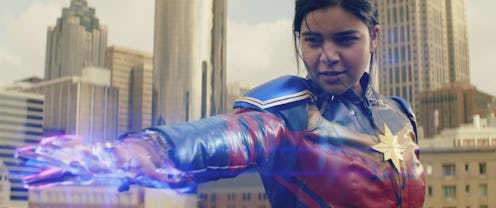Streaming
Kamala Khan Explores Her Heritage Through Her Powers In Ms. Marvel
A mysterious bangle kicks off a cosmic journey.

After the debut of Captain Marvel and WandaVision’s Monica Rambeau, Ms. Marvel is bringing more cosmic energy to the MCU with Kamala Khan (Iman Vellani). Kamala is a 16-year-old Muslim American girl of Pakistani heritage who dreams of a much more fantastical life than the one that she has in Jersey City. She draws fan art of the Avengers, creates YouTube theory videos on them, and absolutely worships Captain Marvel — enough to even cosplay as her at the world’s first “Avenger Con.” Kamala never imagines that a “brown girl from Jersey” could ever really be a hero like Iron Man or Thor, but that changes when she straps on a bangle and discovers she has superpowers of her own.
Kamala’s Powers In The Comics
Kamala Khan was created by editors Sana Amanat and Stephen Wacker, writer G. Willow Wilson, and artists Adrian Alphona and Jamie McKelvie. She was Marvel’s first ever Muslim character to headline her own comic book, Ms. Marvel, which debuted in 2014. Her comic story kicks off when she watches Captain Marvel save a group of civilians and later discovers she has powers, too. The powers are a result of Kamala coming in contact with a vapor called the Terrigen Mist, which has the ability to mutate people with Inhuman genetics. (To recap, the Inhumans are a race of super-powered humans who were created thousands of years ago by the Kree, the alien race that appeared in both Captain Marvel and The Guardians of the Galaxy. The Inhumans were introduced on the very short-lived Inhumans TV show.) The Mists awaken her dormant Inhuman abilities, and Kamala gains polymorph powers, which grants her the ability to shape-shift and have superhuman speed and strength.
“Her being a polymorph seemed to make sense. There’s a really great message there when you think about a young girl, who doesn’t like the way she looks and doesn’t think she fits in, who can change to look like anything,” Amanat explained to Nylon. As soon as she realizes she can change her appearance, Kamala morphs herself into a carbon copy of Carol Danvers and goes out to fight crime looking like the blond Captain Marvel. “That was a very specific choice we made because of her thinking that the ideal and the concept of strength and beauty and perfection is someone who is literally her opposite in terms of looks,” Amanat said.
Kamala’s relationship to her powers revolves around her coming to terms with her own identity, and it’s only when she accepts who she is — a young Pakistani American woman who is not just meant to be a double of a white heroine — that she fully embraces her self-dubbed “Embiggen” powers.
How Kamala’s Bangle In The Show Changes Things
Though Amanat produces the series alongside head writer Bisha K. Ali, Ms. Marvel’s powers in the show are different compared to the comics. Whereas comics Kamala often used her Embiggen powers to stretch and enlarge different parts of her body, in the show her powers are awakened by a bangle that once belonged to her mysterious great-grandmother. Instead of stretching her body, show Kamala is able to summon crystalline-looking structures, which she uses as shields, jumping pads, and yes, even enlarged fists.
While this change inspired some early fan backlash, Marvel Studios president Kevin Feige told Empire that adaptations are rarely an “exact translation” of the source material. “[Kamala] came about in a very specific time within the comic-book continuity. She is now coming into a very specific time within the MCU continuity. And those two things didn’t match,” he said, likely alluding to the overall lack of Inhumans in the MCU. He added that her giant hands and arms are still there “in spirit, if not in stretchy, plastic-type ways.” And in keeping with the themes of the show, her powers still bring up questions of her “own past and her heritage and lineage,” and allow her to delve into her own feelings about being a Muslim Pakistani girl.
And ultimately, the show still stays “true to the character in the comics,” Ali explained during a press conference for the series. “Every single person involved in this project loves those comics deeply and personally from their full hearts. I think we’re all committed to that love, so it wasn’t a case of — I didn’t rock up and say, ‘Hey Kevin [Feige]! I know, let’s throw out the powers!’” She said that changing up the origin of Kamala’s powers was ultimately a “group decision” that allowed them to see how she “fit into this web of storytelling” within the MCU, while still “staying true to this beautiful, incredible character that Sana had created over on the publishing side.”